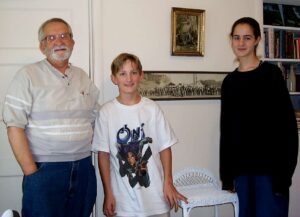Way back at the turn of the present century, an oral history project was undertaken by a group of two dozen Mendocino Middle School children. This group of youngsters, now twenty years older, has left us a valuable record of twelve “Old Timers” and their experiences here on the coast. The project, led by Deena Zarlin, past Kelley House board member and active in the educational community at that time, had the these student interviewers and interviewees:
- Jonathan Matlin talking to Emery Escola
- Adam Channel and Jennifer Vought interviewing Richard Silvera
- Madela Linder and Lola Thornton questioning Homer and Lillian Drinkwater, with Joshua Lawlor as technical recorder
- Sadie Pepper and Adam Channel speaking with Dave Sverko
- Morgan Matthews and Will Tomlinson talking with Alvin Mendosa
- Cody Reber and Sadie Pepper putting questions to Lena Luzzi, helped by Toby Travelli, Janice Sverko and Christian Sverko, and with Will Tomlinson as technical recorder
- Tayloe Dines and Carmy Sciaretta speaking with Lennard Peterson with Steve Lyon as technical recorder
- Charlie Carter and Kyle Houghton interviewing Dolly Efishoff, with Travis Bell as technical recorder
- Marina Almquish Zekley and Adams Mathews talking to Eleanor Atwood Smith, with Shawn Spiller as technical recorder
- Genevieve Gardner and Sam Humphries interviewing Foggy and Connie Gomes
- Morgan Matthews and Travis Evans meeting with Eddie and Clytie Mathews
In the next few months, this column will publish, for the first time, excerpts from these revealing interviews. The conversations encompassed a range of subjects, from family origins, to recreational pastimes, to what has changed — and not changed — in Mendocino.

We’ll start off with the interview Morgan Matthews and Will Tomlinson conducted with Mendocino-born Alvin Mendosa, a gentleman who is still with us today. Will asks, “Could you tell us about how your family came to Mendocino?” And Alvin replies that his father Joe’s side of the family came from the Azores Islands off the coast of Portugal. His mother, Mamie Gordon, had family that hailed from Germany and England via Australia, landing in California at Cuffey’s Cove just north of Greenwood/Elk. He then explains his family’s business, Mendosa’s Hardware and Grocery, and his role in it.
When asked what it was like growing up in Mendocino and his school experiences, Alvin says, “I think Mendocino was a wonderful place to grow up and I think it was a wonderful place to raise children, which I had two of. The school was where the recreation center is now – that was the elementary school. The high school was where it is now, but it was the old high school, the two story one with a cupola. Beautiful building. So they cut down the hill [in 1949] seven feet to have a larger area so they could a put a bigger school there.”
About things he did in his spare time, Alvin tells us, “There was a building called the Odd Fellows Hall in Mendocino. It was on Ukiah Street, the corner of Ukiah and Kasten. That was an old time dance floor. I guess first it was the Odd Fellows Hall, the organization, and then it was turned into a skating rink. And then of course we did a lot of camping out on Big River when I was a child. In fact when I was maybe two or three years (no more than two), we camped up by what is called the Piccolotti’s Ranch. It’s what is called a Boy Scout camp, according to my mother’s story when she was alive. Then further on, we camped down the river when I was a child, and then after I was married and had children, then we would go out there and camp. So it was a great part of our summer that was spent out in Big River. It was right along the side of the river and we had a camp there, and sometimes I would even commute back and forth to town to work when it was my turn. So it was kind of neat.”
Morgan asks, “Mendocino is known for its water towers and windmills, when there were a lot more than there are today. Could you tell us something about that?” And Alvin replies, “Well they’re kind of a cutesy thing now, kind of a tourist thing. But when I was young, windmills and water towers, that was a functional way of getting your water. You had a well, and then up on top of it you have what you call a pump jack, and the windmill was of course powered by wind. That’s what pumped your water up to your tank, and then when your tank was full of water, it would gravitate down into your house. You wouldn’t have forty, fifty pounds of pressure, but you would have maybe twenty pounds, so you had running water. And it was a very functional thing, and you didn’t have to pay an electric bill for it, it was just there. I learned at a young age how important they were because it was my job to pump water, and all it was is you went outside and you took this lever and you turned it and you put it forward and then the windmill started turning around, and then it would start pumping water.”
We are fortunate that so many people over the years have understood the importance of taking down the memories of those who were here before us, and that many of these stories are preserved here in the Kelley House Vault. If you would like to hear these recorded voices or read the stories in full, just give us a call at 707/937-5791 and we’ll set you up for a visit at our research office on Albion Street in Mendocino. Our hours are Monday through Friday 1:00 to 4:00, or email us at curator@kelleyhousemuseum.org.